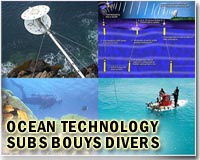| . |  |
. |
Venice, Louisiana (AFP) May 6, 2010 Oil may not yet be washing ashore in large quantities in Louisiana but an environmental disaster is already unfolding deep down in the Gulf of Mexico and in the swirling currents on its surface, experts warned Thursday. "Everyone is focusing on the beaches and coastal wetlands, which, goodness knows are important enough, but we're missing many of the already ongoing ecological effects of the spill," Doug Rader, chief ocean scientist at the Environmental Defense Fund, told AFP. Louisianans and Floridians were warily watching their beaches and wetlands and laying down booms to trap any sludgy mixtures of oil and sea organisms that might wash ashore in key tourist and wildlife expanses on the US Gulf coast. Wildlife officials in Louisiana Thursday reported finding two lifeless oil-coated gannets in fishing waters near the Grand Gosier Islands off the coast of the southern state. But other, much less visible, lethal effects of the spill could have an equal if not greater impact on the region. Toxins in the crude oil that is still flooding out of the pipework of a sunken rig, mix with the tiny larvae of sea animals that move with the surface currents to nearby and far-away spawning zones. "That surface zone is where the oil is at its most toxic and the animals are at their most sensitive," said Rader. "This could wipe out an entire generation of snappers, groupers and other fish." If the oil gets into areas where fish are spawning, "You're affecting the offspring, so that could have effects for a couple years," said LuAnn White, a toxicologist at Tulane University's Center for Applied Environmental Public Health. With the complex network of currents in the northern Gulf threatening to overlap the spill area and suck the pollution downstream, "a whole litany of really important essential habitat and ecosystems" are in danger, said Rader. "People have been thinking of the beaches and wetlands of the northern Gulf in terms of shorebirds and people sitting on the beaches, and hotels and tourism, but the surfzone just adjacent to the beach is a really important foraging ground for all sorts of sea creatures." Of course, the oil doesn't just float on the surface and latch onto currents heading to Florida, the western Atlantic and potentially into the Gulf Stream. It is also taken up and held onto by particles that sink to the bottom of the sea in a drizzle of hydrocarbons and toxins. "The reason that's disproportionately important with this spill is because where the spill is overlies one of the most important ancient deepwater coral reefs in the northern Gulf -- Viosca Knoll," said Rader. Coral reefs not only provide protection and shelter for many species of fish but also help to control how much carbon dioxide is in ocean waters and protect coastlines from strong currents and waves. "The oil spill is raining down little bits and pieces of toxic material on this multi-thousand-year-old reef," said Rader. The rain of oil and toxins is also finding its way into sediment on the sea floor, which is a source of food for a number of sea creatures. "Oil tends to stay in sediment for a long time, so any animal that feeds there is likely to be contaminated itself," said Michael Jasny, a marine mammal specialist and policy adviser at the Natural Resources Defence Council. As marine animal eats marine animal and birds eat the contaminated sea creatures, the toxic mess will make its way from the marine food chain into the terrestrial food chain, the experts said. Responders have taken a number of steps to try to keep the oil from reaching the coast, including burning it off the surface of the sea and adding a dispersant to it which breaks it up into smaller bits -- but which Rader says exacerbates the situation because the dispersed oil "just goes somewhere else." Massive booms are being laid offshore to corral the oil before it reaches land and soaks into the fragile wetlands of the Gulf Coast, and efforts were under way Thursday to lower a massive dome onto the main leak to cap it. But none of those moves could reverse the effects of the toxic sludge that's already in the water. "This spill will go on even if the source of oil is shut down," said Rader. "And it will impact a much wider array of important marine ecosystems than people are thinking and have ramifications for entire communities on the Gulf of Mexico."
Share This Article With Planet Earth
Related Links Water News - Science, Technology and Politics
 Catch 'em if you can: Oil slick no worry for sport fishermen
Catch 'em if you can: Oil slick no worry for sport fishermenVenice, Louisiana (AFP) May 6, 2010 The fishing is good, and the giant oil spill in the Gulf of Mexico has not yet made it here, so Rickey Brouillette saw no reason to cancel his plans to wet a line off Louisiana's coast. "No problem - just won't take as much grease when you fry them," the 52-year-old joked on Thursday after stepping into a fishing guide's skiff that would take him and three others out for the afternoon. ... read more |
|
| The content herein, unless otherwise known to be public domain, are Copyright 1995-2010 - SpaceDaily. AFP and UPI Wire Stories are copyright Agence France-Presse and United Press International. ESA Portal Reports are copyright European Space Agency. All NASA sourced material is public domain. Additional copyrights may apply in whole or part to other bona fide parties. Advertising does not imply endorsement,agreement or approval of any opinions, statements or information provided by SpaceDaily on any Web page published or hosted by SpaceDaily. Privacy Statement |